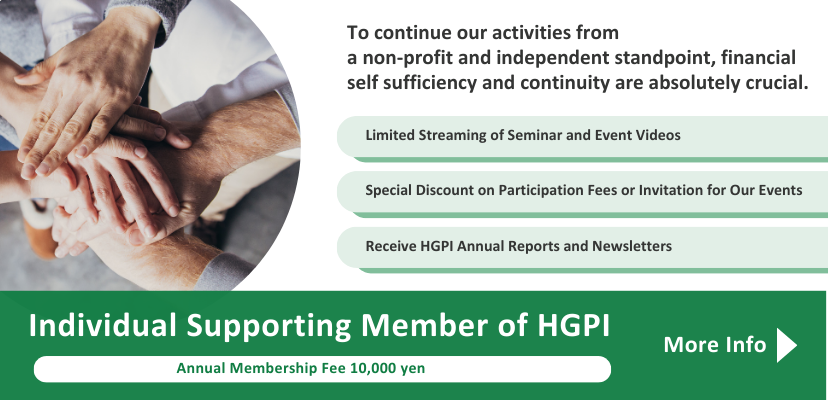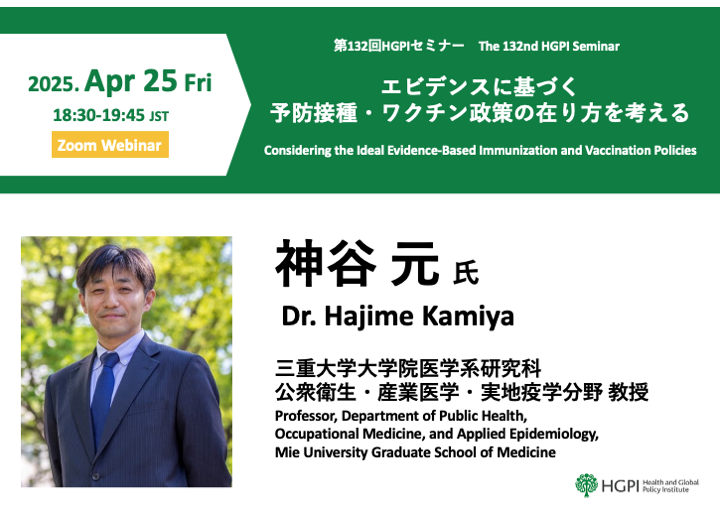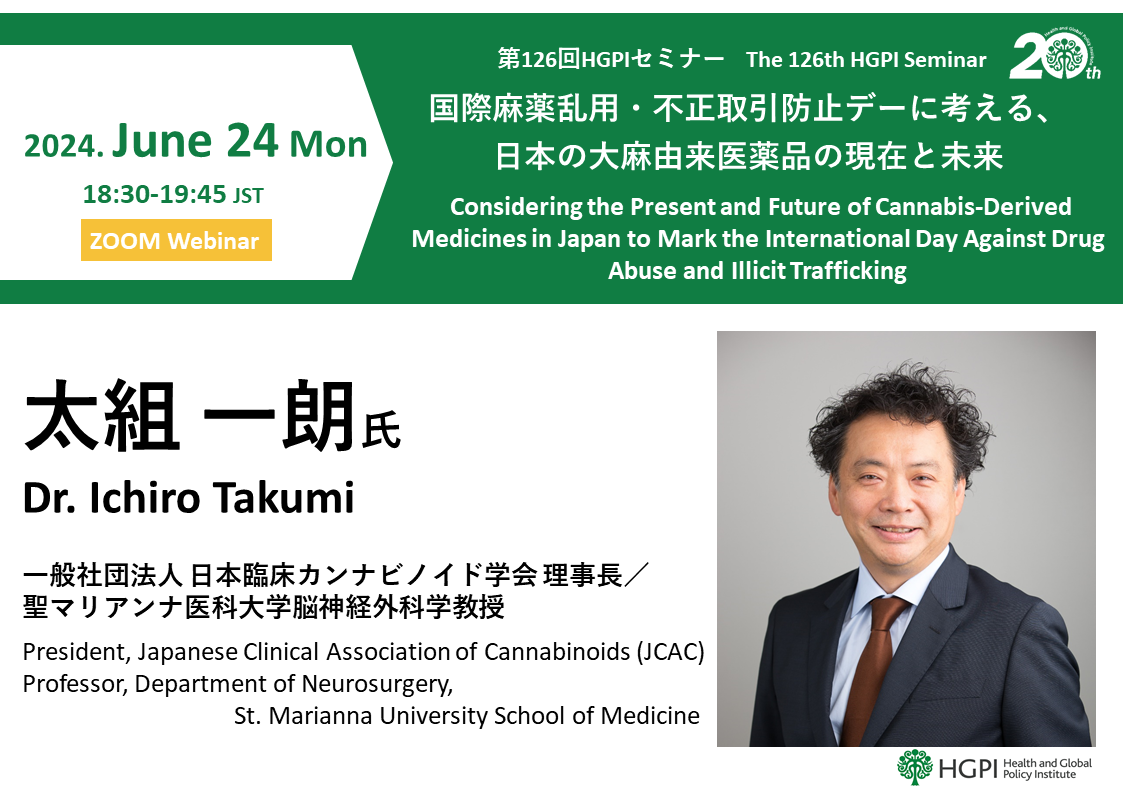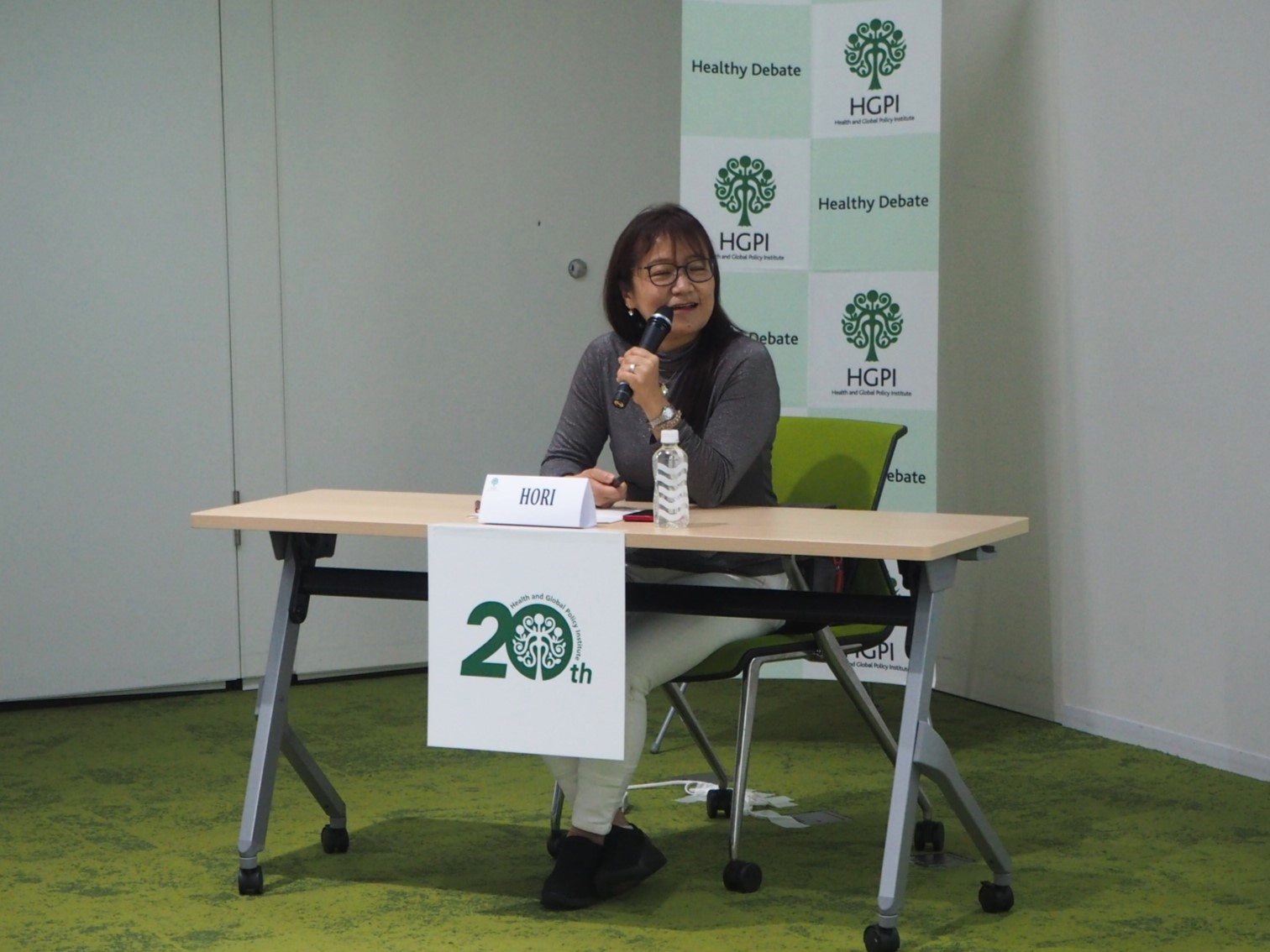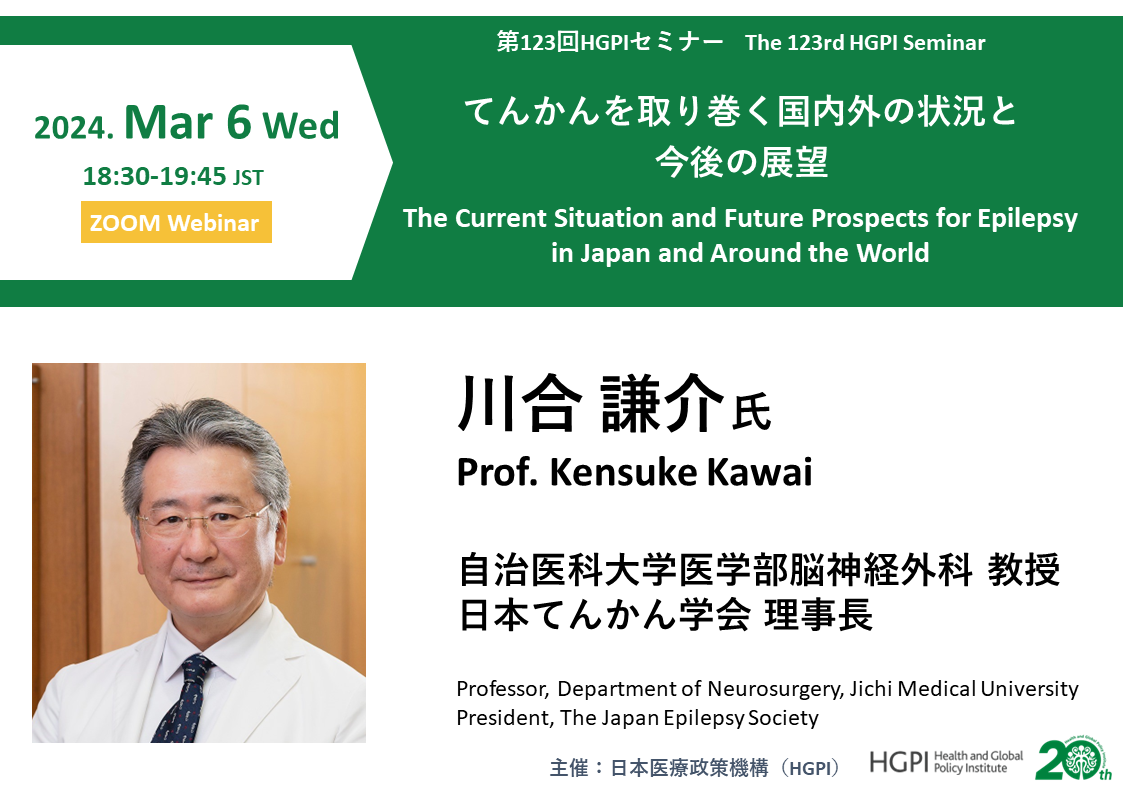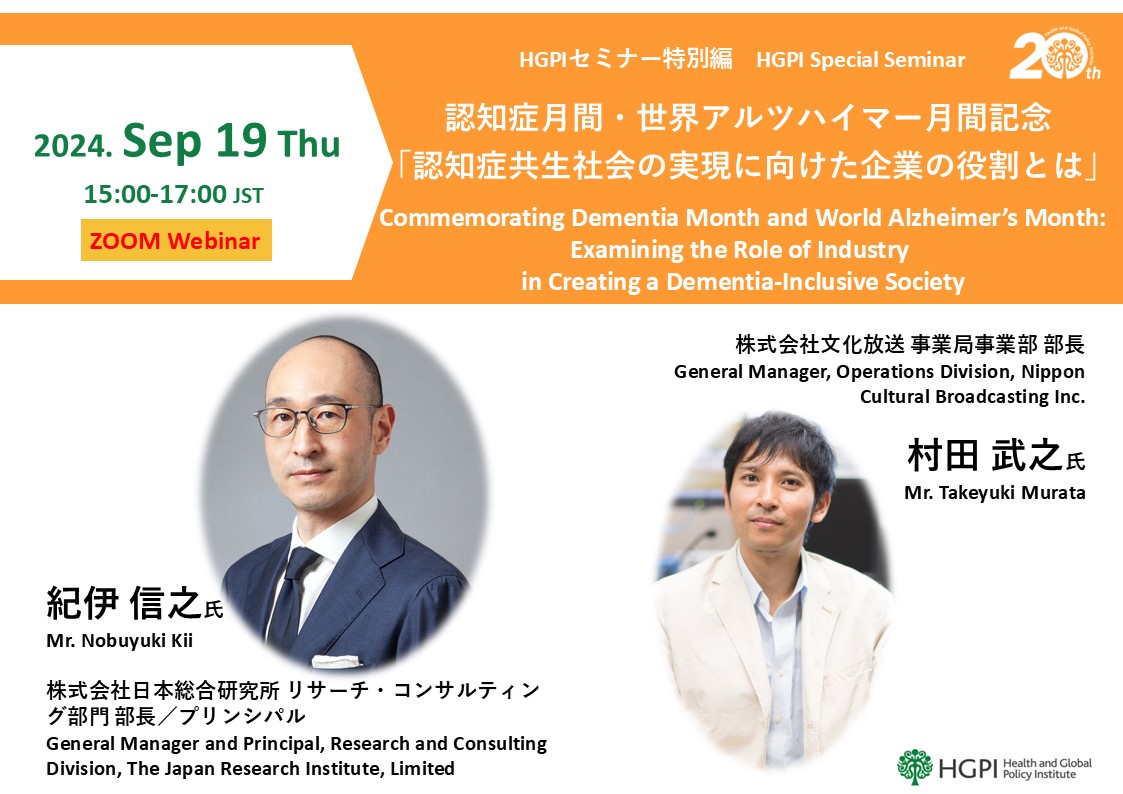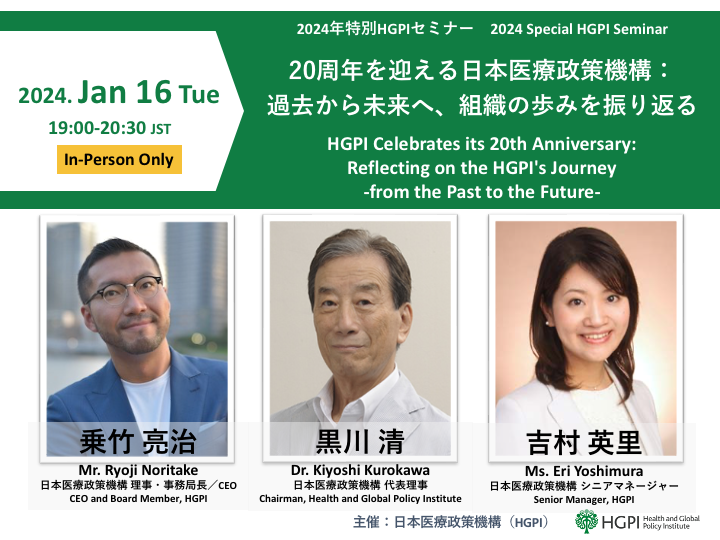[Event Report] The 125th HGPI Seminar “Progress and Prospects for Domestic Measures on Health Problems Caused by Alcohol” (May 24, 2024)
date : 3/31/2025
Tags: HGPI Seminar, NCDs, Other activities
![[Event Report] The 125th HGPI Seminar “Progress and Prospects for Domestic Measures on Health Problems Caused by Alcohol” (May 24, 2024)](https://hgpi.org/en/wp-content/uploads/sites/2/HGPI_20240524_125thHGPIseminar_Eyecatch_rev-1.jpg)
For the 125th HGPI Seminar, we hosted Dr. Sachio Matsushita, who chaired the study group that prepared the “Guidelines on Alcohol Consumption.” Dr. Matsushita shared the history and current state of domestic measures for reducing alcohol-related health problems, the background to the preparation of the “Guidelines on Alcohol Consumption,” and future prospects for efforts in this area.
<POINTS>
- Alcohol causes various physical, mental, and social problems as well as 3 million annual deaths.
- Japan enacted the Basic Act on Measures against Alcohol-related Harm in response to the World Health Organization (WHO) Global Strategy, but some have criticized it as lax on alcoholic beverage pricing and marketing.
- The Ministry of Health, Labour and Welfare (MHLW) published guidelines on alcohol use in April 2024. They recommend monitoring alcohol intake based on net alcohol content and provide information on disease risk by amount consumed to encourage people to rethink their consumption.
- In addition to continuously monitoring the status of health problems caused by alcohol, raising awareness, and establishing health facilities, in the future, it will also be necessary to introduce comprehensive all-of-society measures that include advertising regulations or efforts from eating or drinking establishments.
The harmful effects of alcohol were not well-known until modern times and historically, alcohol has caused problems like increased mortality rates
For much of our history, understanding of the harmful effects of alcohol was not widespread, and alcohol was even considered a medicine for conditions like gout and indigestion. However, in the 1600s, London experienced an epidemic called the “Gin Craze,” when gin use became common among poorer residents. Records show that by 1723, London’s death rate had exceeded its birth rate, driven largely by the deaths of infants and young children, whose mortality rates are heavily influenced by parents. In the early 1900s, epidemiological studies revealed high mortality rates for infants born to mothers with histories of alcohol use. The knowledge of how alcohol harms the fetus was among the factors that contributed to prohibition in North America, Russia, and European countries, but such measures ultimately ended in failure and bootlegging became a source of revenue for criminal organizations.
Alcohol is a substance associated with physical, mental, and social problems
The WHO defines “harmful use of alcohol” as “drinking that causes detrimental health and social consequences for the drinker (harmful drinking), the people around the drinker and society at large, as well as patterns of drinking that are associated with increased risk of adverse health outcomes (hazardous drinking).” In 2016, it was estimated that the harmful use of alcohol leads to 3 million annual deaths. Harmful use of alcohol accounts for 5.3% of all deaths, which is greater than mortality rates for tuberculosis, HIV/AIDS, diabetes, hypertension, digestive system diseases, traffic accidents, or violence. Alcohol use is also associated with a variety of problems other than physical diseases. For example, the negative effects of fetal alcohol exposure, underage drinking during childhood and adolescence, and abuse due to parental alcohol consumption have all been linked to drinking. In adults, harmful use of alcohol can lead to organ damage, alcoholism, sleep disorders, or depression, and has even been linked to suicide. It has also been shown to be associated with social problems like domestic violence, drunk driving, workplace absenteeism, violence, and accidents.
Discovering how alcohol consumption harms health led to progress in global countermeasures and a Basic Act in Japan
After the harmful effects of alcohol became clear, the WHO adopted the “Global strategy to reduce the harmful use of alcohol” (hereinafter, the “Global strategy”) in 2010. Japan later enacted the Basic Act on Measures against Alcohol-related Harm (hereinafter, the “Basic Act”) in 2013. In the Global Strategy, the WHO identified six main areas and laid out numerical targets and highly influential and effective strategies for each area.
In response to the Global Strategy, an academic society, a patient advocacy organization named the Japanese Abstinence Federation, and a civil society organization named the National Citizens’ Association for Alcohol and Drug Problems (ASK) established the Network to establish and promote the Basic Act on Measures against Alcohol-related Health Harm (AL-HOU-NET) and began campaigning for the enactment of a Basic Act. Their efforts were backed by academic societies like the Japan Medical Association, the Japanese Nursing Association, the Japanese Society of Gastroenterology, the Japan Society of Hepatology, and the Japanese Society of Internal Medicine, as well as by the Japan Primary Care Association and the Japanese Psychiatric Hospitals Association. They received further support from a nonpartisan group of Diet members interested in alcohol issues called the Federation of Diet Members for Tackling Alcohol-Related Problems. These efforts led to the enactment of the Basic Act in December 2013. The process that led to the enactment of this Basic Act drew global attention due to its involvement of many stakeholders. However, it has been pointed out that Japan’s measures are weak in terms of regulatory measures to control alcohol consumption through a population approach; in regulations on advertising and sales or limiting opportunities for consumption; as well as in areas like setting prices, increasing liquor taxes, and developing guidelines for the use of these two measures.
To implement measures for alcohol, in accordance with the Basic Act, the Government of Japan formulated the Basic Plan for Promotion of Measures against Alcohol-related Harm (hereinafter referred to as the “Basic Plan”). The Basic Plan is currently in its second phase (FY2021 to FY2025) and includes two priority issues. The first is to reduce by 13.0% for men and 6.4% for women the percentage of people whose alcohol consumption places them at heightened risk of lifestyle diseases; to eradicate underage drinking; and to eradicate drinking during pregnancy. The second priority aims to establish collaborative Councils for Measures against Alcohol-related Harm in all prefectures and government-designated cities and that meet regularly; and to achieve continuous growth in the percentage of people who possess accurate knowledge and understanding of alcohol dependence while decreasing the number of cases of harmful alcohol use. Relevant indicators will be established for each of these priority issues to evaluate efforts.
The MHLW’s alcohol consumption guidelines aim to help people understand their own disease risks in terms of pure alcohol intake
One of the ten Basic Measures in the Basic Act aims to promote education and raise awareness, which led to the compilation and formulation of alcohol consumption guidelines. The guidelines were developed to teach people how to grasp their total intake of pure alcohol and inform them of the disease risks associated with that amount. The detailed information it provides regarding alcohol intake volume and risk for the most common diseases is based on the latest evidence. Recent studies have shown that consuming even small amounts of alcohol increases the risk of health problems. In particular, compared to men, women face greater risks of physical effects with smaller amounts. For this reason, the guidelines do not mention appropriate alcohol consumption amounts. It also must be noted that the amount of pure alcohol consumption associated with increased risk of lifestyle disease (40g for men and 20g for women) does not indicate a standard value for how much alcohol is safe to consume. Expectations are high that these guidelines will provide people with an opportunity to consider their own alcohol consumption and disease risk.
While society possesses a high awareness toward alcohol consumption and liver disease risk, there is less recognition of the fact that alcohol also increases risk for other diseases like colorectal cancer, dementia, and breast cancer. For example, worldwide, it is known that the risk of breast cancer increases in proportion to the amount of alcohol consumed, especially for women, so steps must be taken to raise awareness.
The presence of enzymes that break down alcohol have been shown to have a significant impact on alcohol-related cancer risk. The strong influence of social factors on drinking means that people sometimes consume alcohol even if they lack the enzymes to metabolize it. It will be necessary to raise awareness that such consumption increases the risk of disease, particularly for digestive system cancers.
Future efforts for the health problems caused by alcohol must include comprehensive measures like disseminating knowledge, establishing health institutions, and implementing measures at eating or drinking establishments
The COVID-19 pandemic demonstrated that social conditions have a profound influence on how people consume alcohol, so in the future, we must continue regular monitoring of real-world circumstances surrounding alcohol consumption and health problems. At the same time, it will also be important to disseminate knowledge about the health problems caused by alcohol while working to eliminate prejudice and discrimination against alcohol addiction. To detect alcohol-related health problems early, it will be necessary to popularize an initial intervention method called SBIRT (which stands for Screening, Brief Intervention, Referral to Treatment) and to establish health institutions that can respond to problems related to alcohol consumption.
It will also be important to advance efforts at eating or drinking establishments and to create an environment that prevents over-consumption. Such measures might include preventing intoxicated people from being served additional alcohol or approaching establishments that offer all-you-can-drink menu options.
[Event Overview]
- Speaker: Dr. Sachio Matsushita (Director, National Hospital Organization Kurihama Medical and Addiction Center and Visiting Professor, Department of Neuropsychiatry, Keio University School of Medicine)
- Date & Time: Friday, May 24 , 2024; 18:30-19:45 JST
- Format: Online (Zoom Webinar)
- Language: Japanese
- Participation Fee: Free
- Capacity: 500 people
■Profile:
Dr. Sachio Matsushita (Director of Kurihama Medical and Addiction Center and Visiting Professor, Department of Neuropsychiatry, Keio University School of Medicine)
After graduating from Keio University School of Medicine, he began his career as a psychiatrist at Kurihama Medical and Addiction Center in 1988. Post-doctoral fellow at the National Institute on Alcohol Abuse and Alcoholism from 1993 to 1995. After returning to Kurihama Medical and Addiction Center in 1995, he received a Ph.D. in psychiatry from the Keio University School of Medicine in 2010. He became deputy director in 2011 and has served as director since 2022. He has chaired the committee of the development of the first drinking guideline in Japan.
Top Research & Recommendations Posts
- [Research Report] Perceptions, Knowledge, Actions and Perspectives of Healthcare Organizations in Japan in Relation to Climate Change and Health: A Cross-Sectional Study (November 13, 2025)
- [Research Report] The 2025 Public Opinion Survey on Healthcare in Japan (March 17, 2025)
- [Policy Recommendations] Mental Health Project: Recommendations on Three Issues in the Area of Mental Health (July 4, 2025)
- [Policy Recommendations] Developing a National Health and Climate Strategy for Japan (June 26, 2024)
- [Research Report] The 2023 Public Opinion Survey on Satisfaction in Healthcare in Japan and Healthcare Applications of Generative AI (January 11, 2024)
- [Policy Recommendations] Recommendations on Strategic Investments in Policies for Brain Health to Revitalize Japan: Hopes for the New Administration (December 1, 2025)
- [Policy Recommendations] Reshaping Japan’s Immunization Policy for Life Course Coverage and Vaccine Equity: Challenges and Prospects for an Era of Prevention and Health Promotion (April 25, 2025)
- [Announcement] HGPI Endorses the “Belém Health Action Plan” (November 14, 2025)
- [Announcement] HGPI Joins Global Green and Healthy Hospitals (August 1, 2023)
- [Research Report] AMR Policy Update #2: WHO’s First Report on Fungal Infection—Bridging the Gap Between Clinical Practice and R&D
Featured Posts
-
2025-12-09
[Event Report] Special Seminar “Rising to New Challenges in Health Sciences for Future Society: Novel Developments in the Field of Epilepsy in Japan and Globally” Belgium Pavilion Special Seminar, World Expo 2025 Osaka, Kansai (September 18, 2025)
![[Event Report] Special Seminar “Rising to New Challenges in Health Sciences for Future Society: Novel Developments in the Field of Epilepsy in Japan and Globally” Belgium Pavilion Special Seminar, World Expo 2025 Osaka, Kansai (September 18, 2025)](https://hgpi.org/en/wp-content/uploads/sites/2/HGPI_20250805_mental-health-expo-eyechatch.png)
-
2025-12-11
[Event Report] Core Components of Universal Health Coverage (UHC): Achieving “Healthcare Without Financial Hardship” in Asia-Pacific and Japan (December 5, 2025)
![[Event Report] Core Components of Universal Health Coverage (UHC): Achieving “Healthcare Without Financial Hardship” in Asia-Pacific and Japan (December 5, 2025)](https://hgpi.org/en/wp-content/uploads/sites/2/HGPI_20251210_Core-Components-of-Universal-Health-CoverageUHC-top.jpg)
-
2025-12-12
[Registration Open] Meaningful Involvement Promotion Project Urgent Symposium “The New Takaichi Administration and Central Social Insurance Medical Council Reform – Ensuring Patients’ Voices are Heard” (January 22, 2026)
![[Registration Open] Meaningful Involvement Promotion Project Urgent Symposium “The New Takaichi Administration and Central Social Insurance Medical Council Reform – Ensuring Patients’ Voices are Heard” (January 22, 2026)](https://hgpi.org/en/wp-content/uploads/sites/2/HGPI_20251208_urgent-symposium-1.png)
-
2025-12-12
[Registration Open] (Webinar) The 140th HGPI Seminar “Early Detection to Reduce COPD Disease Burden: Connecting Clinical Frontiers with Health Policy” (January 27, 2026)
![[Registration Open] (Webinar) The 140th HGPI Seminar “Early Detection to Reduce COPD Disease Burden: Connecting Clinical Frontiers with Health Policy” (January 27, 2026)](https://hgpi.org/en/wp-content/uploads/sites/2/hs140-top.png)
-
2025-12-16
[Discussion Points] Policy Dialogue “Considering Comprehensive Genomic Profiling from the Perspective of Patient Access: Utilizing the Medical Service Fee Reimbursement System and the Mixed Medical Services Program to Meet the Needs of Today” (November 28, 2025)
![[Discussion Points] Policy Dialogue “Considering Comprehensive Genomic Profiling from the Perspective of Patient Access: Utilizing the Medical Service Fee Reimbursement System and the Mixed Medical Services Program to Meet the Needs of Today” (November 28, 2025)](https://hgpi.org/en/wp-content/uploads/sites/2/eyecatch_Policy-Dialogue_Discussion-Points_20251128.jpg)





